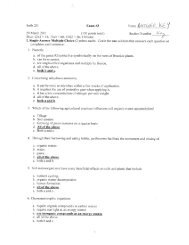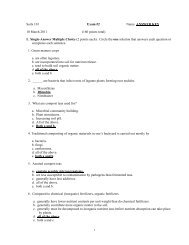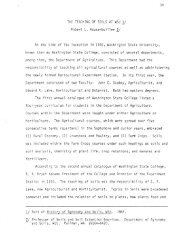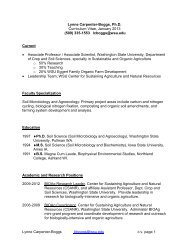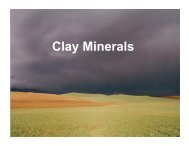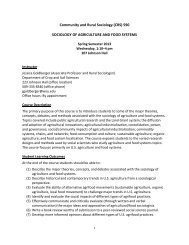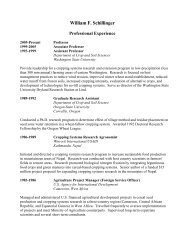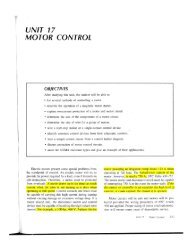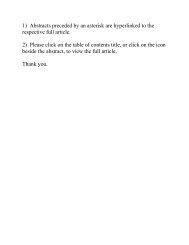2012 Dryland Field Day Abstracts - Dept. of Crop and Soil Sciences ...
2012 Dryland Field Day Abstracts - Dept. of Crop and Soil Sciences ...
2012 Dryland Field Day Abstracts - Dept. of Crop and Soil Sciences ...
Create successful ePaper yourself
Turn your PDF publications into a flip-book with our unique Google optimized e-Paper software.
Part 1. Breeding, Genetic Improvement, <strong>and</strong> Variety Evaluation Page 21<br />
Part 1. Breeding, Genetic Improvement, <strong>and</strong> Variety Evaluation<br />
Winter Wheat Breeding <strong>and</strong> Genetics<br />
A. Carter, G. Shelton, R. Higginbotham, K. Balow, <strong>and</strong> J. Hansen; <strong>Dept</strong>. <strong>of</strong> <strong>Crop</strong> <strong>and</strong> <strong>Soil</strong> <strong>Sciences</strong>, WSU<br />
Wheat breeding in the state <strong>of</strong> Washington has seen many changes over the last three years. Even with these changes, the Winter<br />
Wheat Breeding <strong>and</strong> Genetics Program at Washington State University remains committed to developing high yielding, disease<br />
resistant, <strong>and</strong> good end-use quality cultivars to release for production. We have begun using many <strong>of</strong> the newest tools available to<br />
the wheat breeding community to accomplish this task. These include association mapping efforts, genomic selection, markerassisted<br />
selection, <strong>and</strong> doubled haploid production. This past year we planted large, diverse sets <strong>of</strong> germplasm for association<br />
mapping <strong>and</strong> genomic selection. In 2011 we planted over 3,000 lines that were selected through marker assisted selection efforts.<br />
We also planted 1,200 DH lines with another 3,500 in the greenhouse which will be ready for fall <strong>2012</strong> planting. Many research<br />
projects have been initiated with other breeding <strong>and</strong> research groups at WSU to seek solutions for various production concerns.<br />
These include drought resistance, stripe rust resistance, nematode resistance, <strong>and</strong> emergence potential. With the continual<br />
interested in Imazamox resistant wheat in the state, we initiated efforts to develop two-gene resistant lines which are being<br />
evaluated in advanced yield trials. We are thrilled about the new technology we have which will enable us to more effectively <strong>and</strong><br />
efficiently breed wheat for the state <strong>of</strong> Washington. We have some excellent breeding lines in the program <strong>and</strong> are excited about<br />
their potential for production in the state.<br />
Otto (WA8092) is the most recent s<strong>of</strong>t white winter wheat released from the program <strong>and</strong> foundation seed will be available for<br />
purchase in the fall <strong>of</strong> <strong>2012</strong>. It is an Eltan/Madsen cross which was backcrossed to Eltan four times. Agronomically, it performs<br />
very similar to Eltan with regard to emergence, plant height, heading date, <strong>and</strong> test weight. Otto has similar to higher yields than<br />
Eltan especially in the presence <strong>of</strong> disease pressure to which Otto is resistant. Otto has snow mold <strong>and</strong> common bunt resistance<br />
similar to that <strong>of</strong> Eltan. The stripe rust resistance is better than Eltan as it picked up seedling resistance genes from the Madsen<br />
parent. Otto also has resistance to eyespot foot rot, which will benefit many growers in the 12-15” rainfall zones where this<br />
disease is becoming more prevalent.<br />
The hard wheat breeding program is also progressing nicely, with efforts focused on both red <strong>and</strong> white wheat. Farnum <strong>and</strong><br />
Bauermeister account for about 30% <strong>of</strong> hard red wheat production in Washington. WA8118 <strong>and</strong> WA8119 are two breeding lines<br />
which will be considered for release in the fall <strong>of</strong> <strong>2012</strong>. Both have good emergence, high yield potential, <strong>and</strong> good disease<br />
resistance. WA8118 also has the Gpc-B1 gene for high grain protein content. We have entered multiple breeding lines into the<br />
variety testing program in hard wheat backgrounds that have three genes for stripe rust resistance, as well as the Gpc-B1 gene.<br />
We are excited to see the potential <strong>of</strong> these lines under diverse production regions.<br />
The Western Wheat Quality Laboratory<br />
Craig F. Morris, USDA-ARS, <strong>and</strong> Brian S. Beecher, WSU<br />
The mission <strong>of</strong> the USDA-ARS Western Wheat Quality Lab is two fold: conduct milling, baking, <strong>and</strong> end-use quality evaluations on<br />
wheat breeding lines, <strong>and</strong> conduct research on wheat grain quality <strong>and</strong> utilization. Our web site: http://www.wsu.edu/~wwql/<br />
php/index.php provides great access to our research. Our research publications are readily available on our web site.<br />
Our current research projects include grain hardness, puroindolines, waxy wheat, s<strong>of</strong>t durum wheat, polyphenol oxidase (PPO),<br />
arabinoxylans, SDS sedimentation test, <strong>and</strong> wheat ash. Our recent publications include the characterization <strong>of</strong> a unique ‘super s<strong>of</strong>t’<br />
kernel trait in wheat, <strong>and</strong> transfer <strong>of</strong> s<strong>of</strong>t kernel texture from Triticum aestivum to durum wheat, Triticum turgidum ssp. durum. A<br />
collaborative analysis <strong>of</strong> wheat endosperm compressive material properties was published in Cereal Chemistry. A study in which<br />
five polyphenol oxidase genes were genetically mapped was published in Theoretical <strong>and</strong> Applied Genetics. Two studies on total,<br />
water-unextractable, <strong>and</strong> water-extractable arabinoxylans <strong>and</strong> oxidative cross-linking in wheat flour mill streams were recently<br />
published in Cereal Chemistry. Other research includes phytochemical composition, anti-inflammatory, <strong>and</strong> antiproliferative<br />
activity <strong>of</strong> whole wheat flour, the molecular characterization <strong>and</strong> diversity <strong>of</strong> puroindoline b-2 variants in cultivated <strong>and</strong> wild<br />
diploid wheat, the prevalence <strong>of</strong> Puroindoline D1 <strong>and</strong> Puroindoline b-2 variants in U.S. Pacific Northwest wheat breeding<br />
germplasm pools, <strong>and</strong> their association with kernel texture, some observations on the granivorous feeding behavior preferences <strong>of</strong><br />
the house mouse (Mus musculus L.), <strong>and</strong> research on the distal portion <strong>of</strong> the short arm <strong>of</strong> wheat (Triticum aestivum L.)




